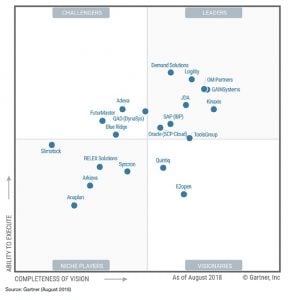Gartner Releases New Supply Chain Planning Magic Quadrant
Gartner Research just released its new Magic Quadrant for Supply Chain Planning System of Record (SCP SOR).
There have been significant vendor position changes since the last Magic Quadrant because some vendors are taking advantage of technology advancements reflecting “changing end user priorities and associated needs, such as support for vertical/horizontal alignment and automated decision making.”
This Magic Quadrant analyzes SCP SORs (the foundational planning layer) that support the “integrate” maturity stage demand and supply planning (Stage 3 in Gartner’s five-stage maturity model).
This is an area that Gartner finds many companies are investing in to provide a strong foundation on which to build more differentiating and innovating capabilities.
Gartner adds that a Stage 3 planning SOR “is usually distinct and separate from the transactional SOR, which is typically encapsulated in various ERP systems.
In essence, the SCP SOR helps to establish a single version of the truth for the supply chain plans, regardless of what the underlying ERP landscape looks like.”
Core Requirements
Gartner considers the following to be core requirements for an SCP SOR:
- Stage 3 S&OP
- Demand planning, including collaborative demand planning
- Inventory planning, including collaborative inventory planning
- Replenishment planning, including collaborative replenishment planning
- Order planning/promising
- Production planning
- Manufacturing scheduling
Nine Technical Competencies
In addition, they list nine key technical competencies to ensure that planning functionality can be utilized effectively across an E2E supply chain:
- Process management
- Unified data, process and analytical models
- Scalability to handle large global planning models
- Performance management and analytics support
- Collaboration support
- Ability to deploy segmented SCP models
- Master data management (MDM)
- Integration to transaction systems
- Ability to propagate plan changes easily across an integrated planning model in a 24/7 environment
Gartner says that “Choosing an SCP SOR is a key decision.
Not only must it provide planning integration and visibility across a supply chain, it also must provide a critical steppingstone in an SCP technology roadmap that will help enable the business’s future SCP aspirations.”
For instance, looking ahead, Gartner predicts that SCP SORs will “increasingly connect plans across multiple businesses.
Planning and execution capabilities also will converge to facilitate more demand-driven, responsive and agile short-term planning across extended value chains.”
So when searching for a SCP solution, Gartner says users should consider three key questions:
- What type and level of planning is the business looking to support now and in the future?
- What type of technology is required? Is it foundational to support planning visibility and integration, or does it need to be more advanced and differentiating to enable the necessary business capabilities?
- As supply chain environments evolve, what type of planning environment will the SCP technology need to support in the future?
The Quadrants
Gartner divides vendors into four quadrants: Leaders, Challengers, Visionaries, and Niche Players.
Leaders offer strong capabilities for SCP SOR vision and execution. They good coverage across Gartner’s three categories of planning capability — Configure, Optimize and Respond.
Challengers are strong on product execution, but have product roadmaps that are not yet closely aligned enough with Gartner’s view of future SCP solutions.
Visionaries articulate a strong SCP SOR vision, understand the changing needs of the SCP market and have a strong roadmap but are not as strong on execution.
Niche Players, while viable for SCP projects, have weaknesses in vision and execution.
The Evaluations
Gartner evaluated, in alphabetical order, the following vendors: Adexa, Anaplan, Arkieva, Blue Ridge, Demand Solutions, e2Open, FuturMaster, GAINSystems, JDA, Kinaxis, Llamasoft, Logility, OM Partners, Oracle, Outperform, QAD (DynaSys), Quintiq, RELEX, SAP (IBP), Slimstock, Syncron, and ToolsGroup. The evaluation criteria and weightings were as follows:
Ability to Execute
- Product/Service – High
- Overall Viability – High
- Sales Execution/Pricing – Medium
- Market Responsiveness – High
- Marketing Execution – High
- Customer Experience – High
- Operations (the ability of the organization to meet its goals and commitments) – Medium
Completeness of Vision
- Market Understanding – High
- Marketing Strategy – High
- Sales Strategy – Medium
- Offering (Product) Strategy – High
- Business Model – Medium
- Vertical/Industry Strategy – Low
- Innovation – High
- Geographic Strategy – Medium









